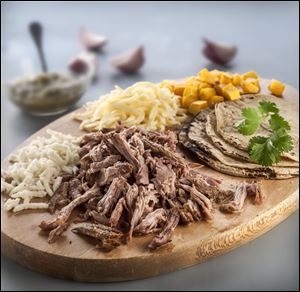
FOOD & NUTRITION
How to rock fusion tacos at home
4/29/2014
Tacos can be just about anything you want such as these pork and roasted squash tacos.
AUSTIN — We tend to snub our noses at the word “fusion” when it comes to food.
After two decades of chefs mashing up every cuisine imaginable to create one too many fried wonton-topped chicken salads, the food professionals who wanted to be taken seriously backed away from using the “f’’ word.
But that doesn’t mean they stopped blending cuisines. The truth is, even the most “authentic” foods are the result of mashing up one food culture with another, says David Joachim, the prolific cookbook author whose newest book, Global Cooking, explores international cuisines from Chile to China.
Now, instead of calling it fusion, we’re calling it “global food,” Joachim says.
So why are tacos, which we think of as Mexican even though many Central and South American countries also serve them, so frequently fused with other cuisines?
’’Tacos are an interesting case study in global cuisine because every culture has some sort of bread wrapped around food,” Joachim says. Tortillas aren’t that different than pita, which is just a stone’s throw from flatbread. When people move from one place to another, even one continent to another, they continue to cook the foods of their homeland but start to incorporate some new techniques and ingredients. Over generations, these small changes become widespread, and suddenly no one remembers an Italy in which there was no tomato sauce.
Take tacos al pastor, Joachim says, which is actually a descendant of the Middle Eastern gyro. A wave of immigrants from Iraq and Lebanon moved to Mexico in the first part of the 20th century, and before long, they weren’t putting the meat sliced from an upright pit into pitas but into corn tortillas instead.
Americans are cooking more globally than they ever have before, either fused with foods they already know or recreating dishes they’ve tried elsewhere, Joachim says.
’’There’s so much flavor available now, thanks in part to the global economy and the skyrocketing interest in food, plus the changes in immigration in our country,” Joachim says. “There’s just so much available in mainstream markets that many [cooks] might not have been aware of even 10 years ago.”
And he’s not just talking about sriracha: In urban areas, it’s easy to find chili pastes from India, Africa and Asia, or spices like cardamom, turmeric and exotic peppercorns. As soon as you have access to an ingredient like lemongrass, Joachim says, you have access to the flavor of an entirely new cuisine that you previously couldn’t prepare at home.
But don’t expect your dish to taste exactly the same as the street food you had in Thailand. “You’re making concessions any time you cook outside the home country because the ingredients are slightly different,” he says.
The quest for authenticity, though noble, is almost always quixotic because “authentic” only exists in the minds of those seeking a singular beginning. Food, however, is a collective, collaborative experience. “You have to look at cuisine as a flowing river of flavor with different tributaries coming in,” Joachim says. “Over the course of history, that river is always changing.”
In his book, the most “authentic” taco recipe is one with potatoes, poblanos and chorizo on a corn tortilla, but he also shares an unexpected mash-up of cuisines: a fiery Kung Pao chicken taco seasoned with sambal, an Indonesian chile paste.
The book also features a recipe for Joachim’s spin on what has become a Los Angeles classic: the bulgogi Korean taco. Traditional bulgogi is beef that has been marinated and grilled and is often wrapped in large lettuce leaves. Serve it in a tortilla instead, and you have one of the hottest food truck trends of the past decade.
That taco is an excellent example of just how simple fusion can be. To explain, Joachim breaks a taco into its core building blocks: a tortilla, meat (or other protein), something crunchy and something tangy or vinegary. Change just one of those elements to incorporate an unexpected flavor or texture — kimchi instead of lettuce, raita or chutney instead of salsa, smoked pork instead of stewed — and you’re on your way to fusion taco nirvana.
These are building blocks that cooks can play around with, but the key is not overdoing it because swapping out too many familiar elements takes away from the “taco-ness” of the taco, Joachim says.
So, where is the line between a taco and a wrap? It gets more blurry by the week, Joachim says. At a youth sporting event recently, he came across a “walking taco,” a small bag of tortilla chips topped with chili, a spin on the Frito-pie-in-a-bag that Texans know well. “That’s not even a wrapped food but they call it a taco,” he says.